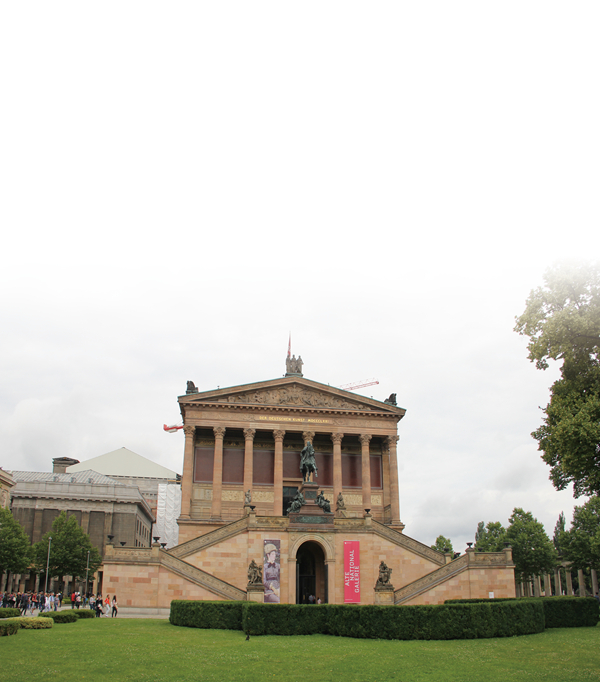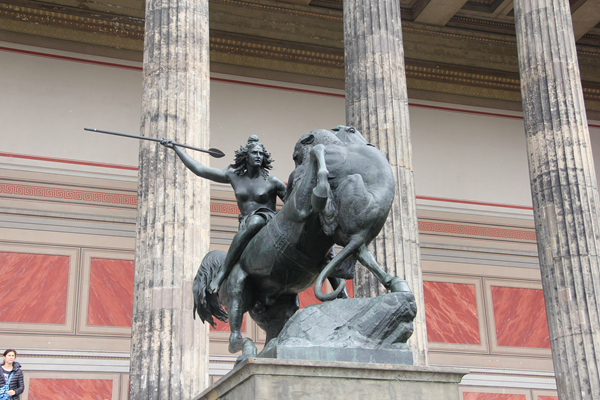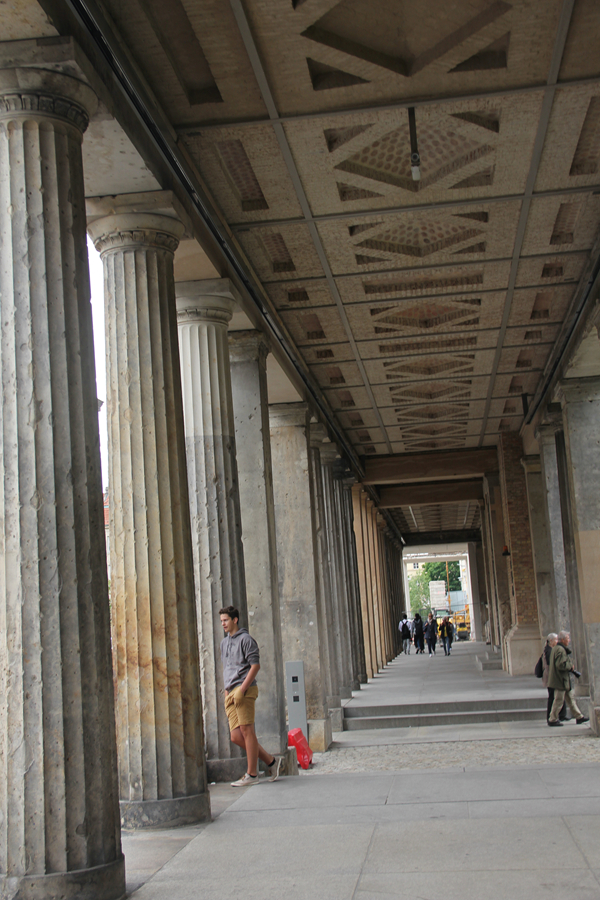


Scene of the Neues Museum in Berlin

Sculpture at the entrance of the Altes Museum gate

Shot Marks in the Second World War are still Visible in the External Colonnade of the Neues Museum in Berlin
On the last evening of my trip in Europe, I was watching a performance in Berlin. nd next to me sat a senior-aged German senior citizen whose thick white moustache lined straight along his upper lip. As a typical German, he was almost in his 70s. After his retirement, he started to learn mandarin and currently could communicate with me in a simple Chinese as well as utilize WeChat App on his mobile phone. In a genuine passion, he recommended a must-see in Berlin, but his limited Chinese and my poor English made his long explanation more confusing to me. Thanks to the versatile Internet, he finally found a picture from the searching engine in his phone and showed it to me. Actually, it was Nefertiti, the Egyptian queen.
It was a quite unexpected fact that the bust of such a famous Egyptian queen as Nefertiti was available in Berlin. Throughout our three-days stay in Berlin, we were always one or two kilometers away from the museum of Nefertiti collection. It was quite a pity that we missed such a priceless opportunity to appreciate her beauty.
The venue of our event that we attended was close to Spree river, and standing on a bridge over the river, we could easily find a giant building in Baroque style as its lofty and round dome was quite outstanding. Taking a closer look, we could recognize it as the Bode Museum with major collections of sculptures and coins of religious themes. Such a museum was already an acme building in our mind, but just behind it there stood another four larger museums, all of which constituted a magnificent complex of museums, i.e., the Museum Island. Starting from the Bode Museum, the Spree river divides in two tributaries branches and in the middle stands the Museum Island. Before the mid-17th century, it had been a royal vegetable garden of the Kingdom of Prussia. Between 1825 and 1830, the Altes Museum (Old Museum) was designed and constructed, and then became the first museum on this island as well as one of the earliest independent museum in Germany. The front of the Altes Museum consists of magnificent colonnade of ancient Greek style in a magnificent manner, facing the old royal palace in Berlin in the past. Sculptures, ancient Greek pottery and mosaics are quite typical here.
Correspondingly, there exists the Neues Museum (New Museum) on the same island. Though it is called “New”, its collection involves the most ancient artworks in human civilization. As the second eldest museum on the island, the bust of Egyptian queen Nefertiti was kept in a separate exhibition hall as the most notable exhibit. In this museum, pictures can be taken with other exhibits except Nefertiti.
The youngest building on this island is Pergamon Museum that was constructed from 1909 till 1930, and it was the only one named after its exhibit. The Pergamon Altar used to be one of the key sacrifice venue in Pergamon, an ancient Greek colonized city-state. The frieze in high relief decorated on the base is an example of sculpture arts in Ancient Greece. Besides, Ishtar Gate, the eighth gate to the inner city of Babylon in the 6th century B.C., was within its collection. The ruins of the Ishtar Gate were discovered in an archaeological survey by German experts in Mesopotamia at the beginning of the 20th century A.D. After that, hundreds of thousands of broken pieces of colored glaze were transported to Berlin, and after being desalted and consolidated, they were pieced together to restore the mysterious charm of that Oriental civilization. Both Pergamon Altar and Ishtar Gate have brought over a million visitors annually to the Pergamon Museum. 
The cream of relics in ancient Babylon civilization and ancient Egypt civilization, the most time-honored civilizations in the world, are still available on the Museum Island. It is said that during the Second World War, 70 percent of the buildings on this island were destroyed and many relics were spread all over Germany. Later on, those relics luckily returned home and those museums were consecutively reconstructed. On many pillars and walls of those museums, some bullet holes are still visible. In 1999, the Museum Island was listed into World Cultural Heritage by UNESCO and reportedly the entire renovation will be completed by 2027.
Though Museum Island is not as well-known as the Louvre, the visual shock by this giant complex is far from verbal description. In a word, this gigantic complex of museums portrays a beauty of noble dignity. Furthermore, in the eyes of architectural fans, those five museums of different styles in varied times, along with the next-door Berlin Dome and the Berlin Palace under renovation, have constituted a miracle of architecture and culture.
